Shinjuku Flaneuring
Between Muji and the Erotic Godzilla
Shinjuku Flaneuring Between Muji and the Erotic Godzilla






<swipe>
Date Spring 2023
Location Tokyo, Japan
Collaborator Kaicheng Zhuang
Advisor Joseph Godlewski, PhD
Exhibition Shinjuku Flaneuring, Syracuse NY
Awards Citation for Excellence in Thesis Design (Britton Memorial Awards)
supported and funded by the SOURCE Fellowship
Shinjuku Flaneuring looks at the material collisions between the Mujis and Godzillas, the former being the zen and hypermodern Japan-ness characterised by Isozaki, the latter being the exhibitionisms of Tokyo’s precarious red light district. As it stands, the municipality’s image of contrast is sustained by alternating on/off hours. So we wondered how can we activate these places of mediatic silence? What are the 0.5-degree activities that can emerge between the on/off binary? We turn to the flaneurs, translators, tourists as the architects of their own environments.
introduction video
Consumption of Oversaturation and Contrast as Urban Tactic
To sustain the iconoclash between consumerist and godzilla, each half of the municipality take turns in switching off. Yet, locals don’t avoid these dark spots, so how do we program for the dividual spaces (Alamazan) that can exist in the gaps of mediatic silence?
In February 2023, we spent a week in Tokyo to document the site across different times of day. We concluded that Consumerist and Godzilla are two sides of the same coin – constantly surveyed, constantly butting heads through image making, programming, and strategic activation of certain parts of the city. The design question became how do we semi-activate these places of mediatic silence? What are the 0.5 places that exist in this urban binary? What are the strategies or programs that punctuate the ambience of moving through these streetscapes?
We reconstructed our walks through the city as linear narratives, the breaks between them are reflective of how they align, disentangle, and offer slippages at moments of inflection. Our interventions act as switchboards that glitches the threshold of what is consumerist and what is Godzilla. Even when it’s not your turn in the spotlight doesn’t mean that you stop being a part of the city. We are rejecting the notion that places are ‘either or’, but instead by hybridizing you develop the agency and image vocabulary to engage with both sides, to be included in a wider range of translations and experiences of the city.

Material Ecology: Point Clouds as Analytical and Generative
In thinking about the role of the translating tourist, or ‘gaijin’ (Japanese for outsider), our cataloguing and exhibition reproduce our flaneuring through Shinjuku as perceptual narrative arcs, evoking the situationists and Venturi + Scott Brown’s “Learning from Las Vegas” and “Two Naifs in Japan”. We are interested in the material culture, or culturally-laden materials, that specify respective visual, sensorial, symbolic experiences of different translations through the lens of iconoclash and resulting affect. The material reality of Shinjuku (furniture, railings, signage, facades…) are “things” (in the Liz Grosz sense, in which sedimented histories are flattened into images that communities organize around to make conventions) that coalesce into an ecology of artifacts that can be strategically re-written and re-embedded into the urban text that produces new translations of how contingencies and adjacencies between Consumerist and Godzilla are cognitively registered. The tourists’ new interpretations of the physical reality would encourage new modes of exchange and possibly unexpected adaptations.

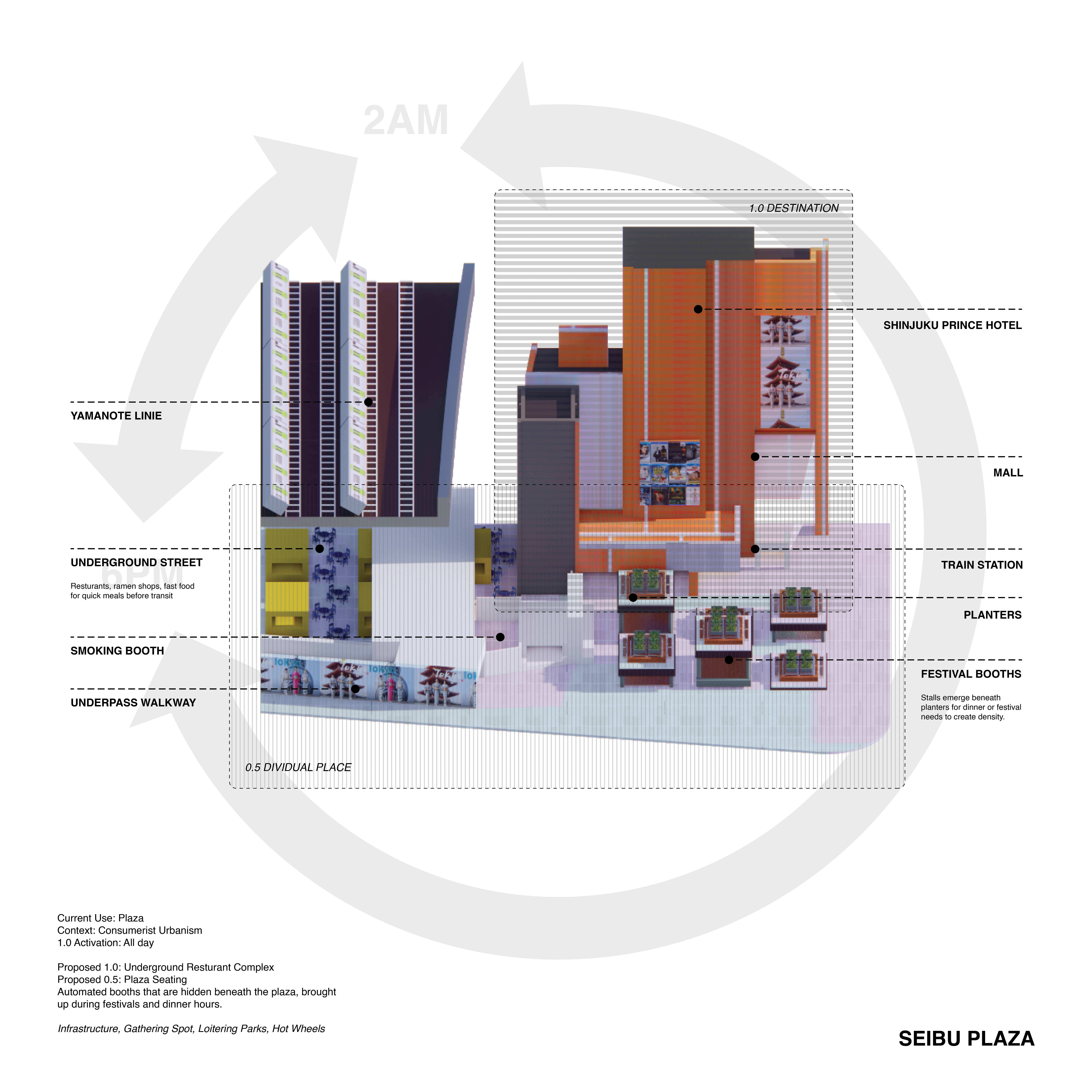
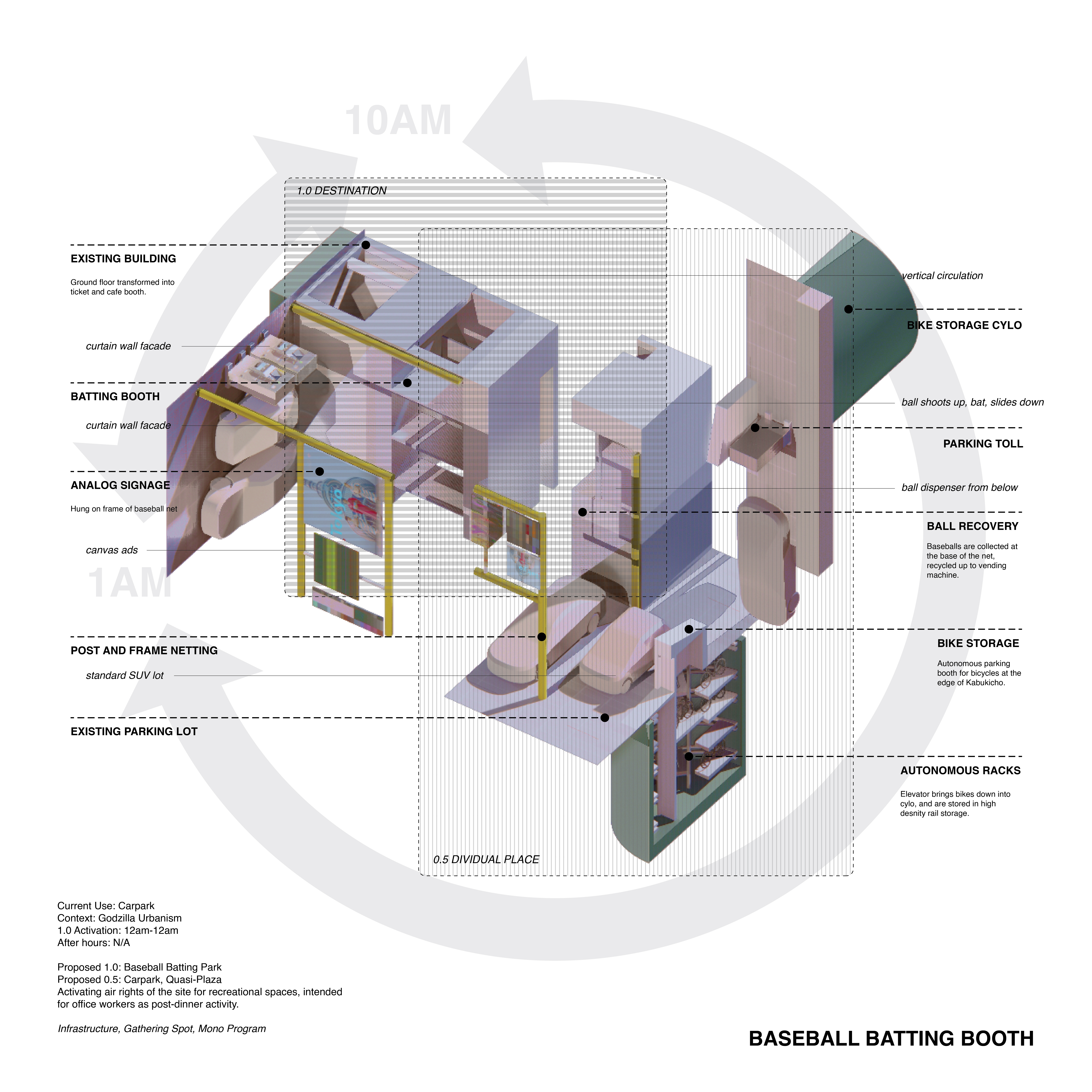


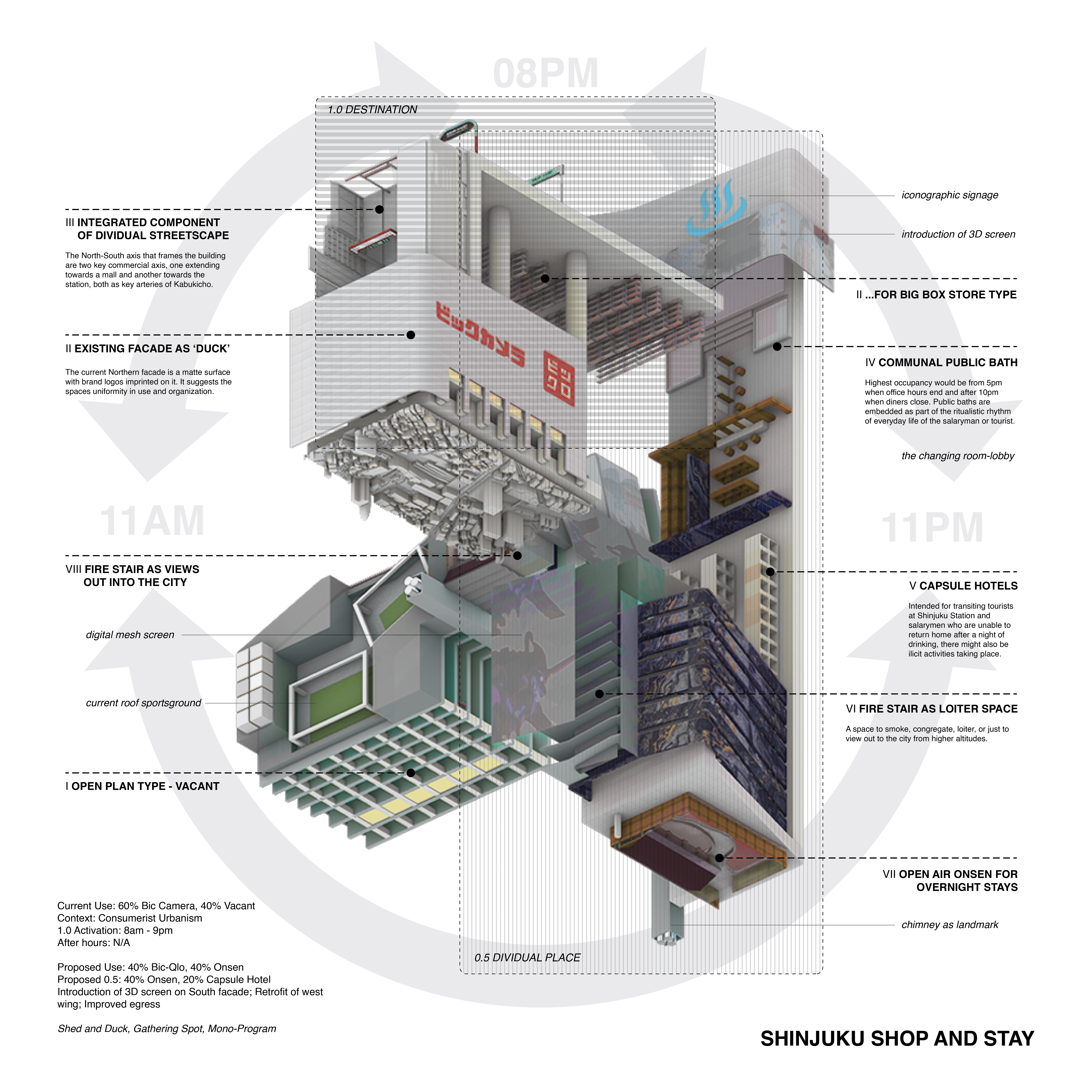


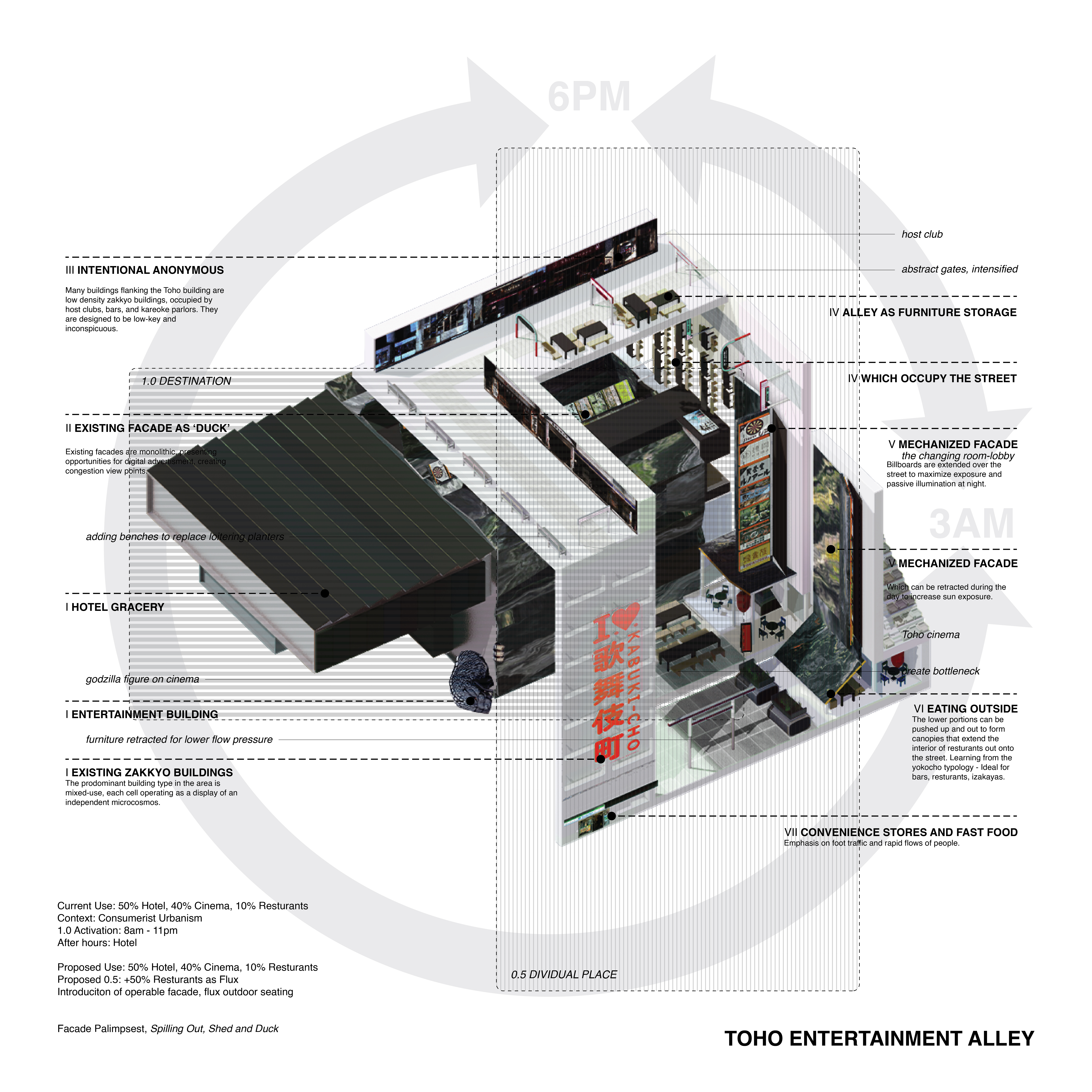
The Exhibition
Central to the presentation is a projection installation that stitches together the urban scenes as documented during their research trip to Japan in early 2023. The model consists of six CNC-milled fragments that each represent a block of Shinjuku, and projected onto them is a stop-motion animation that goes from day to night, pre- and post- design intervention. The block are abstracted representations of point cloud data and photographic documentation. The intention was to create flattened reliefs on plinths that bring the minature to torso level, so when the exhibition goer moves through the models, it simulates the perspective of occupying the street. The material lexicon of the site is catalogued and reproduced onto the models, a series of small hybrid artifacts represent the ecology possible variants that can be used to modify existing conditions or inform new designs.
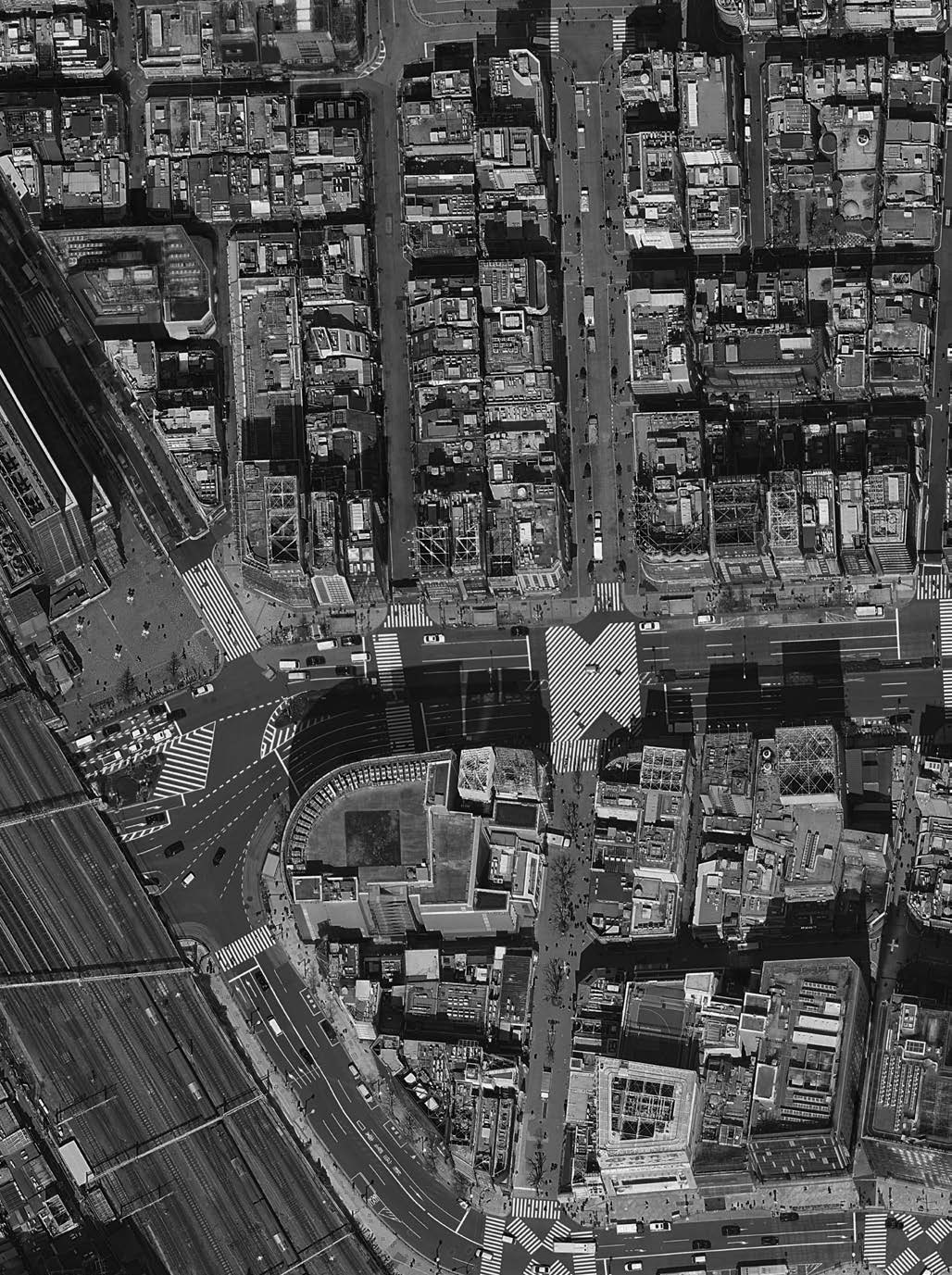
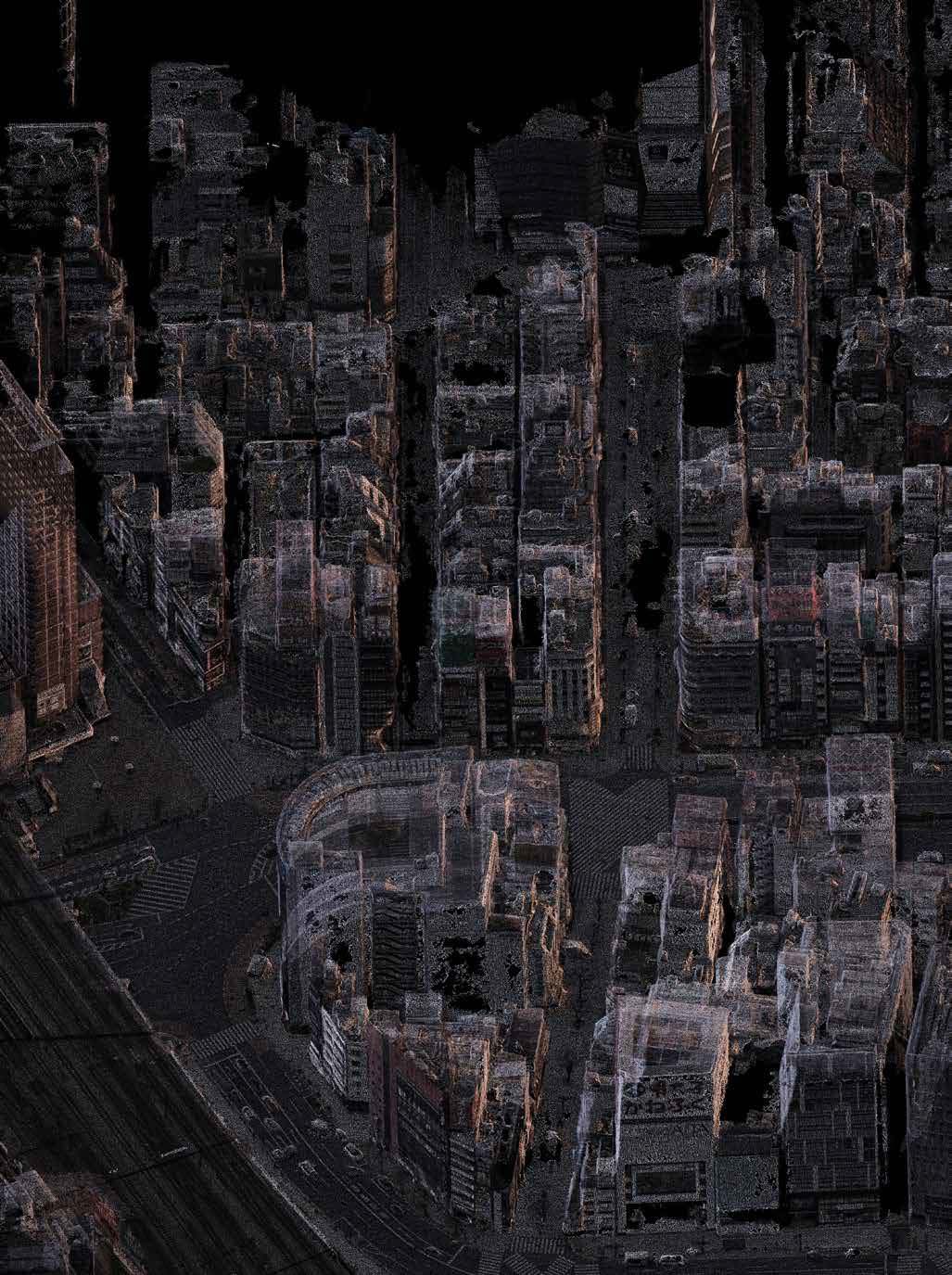






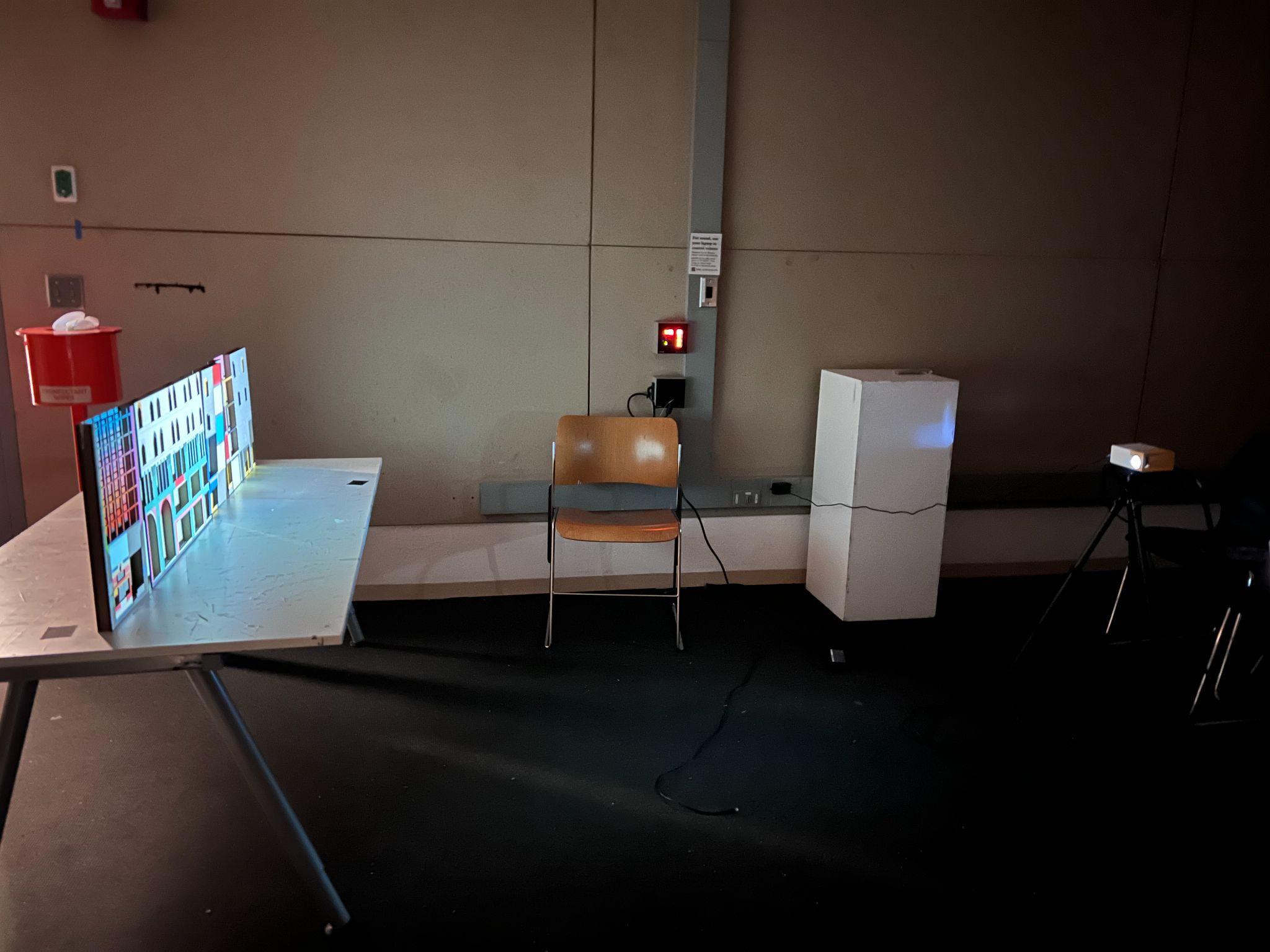




“Between Muji and the Erotic Godzilla” Installation Process
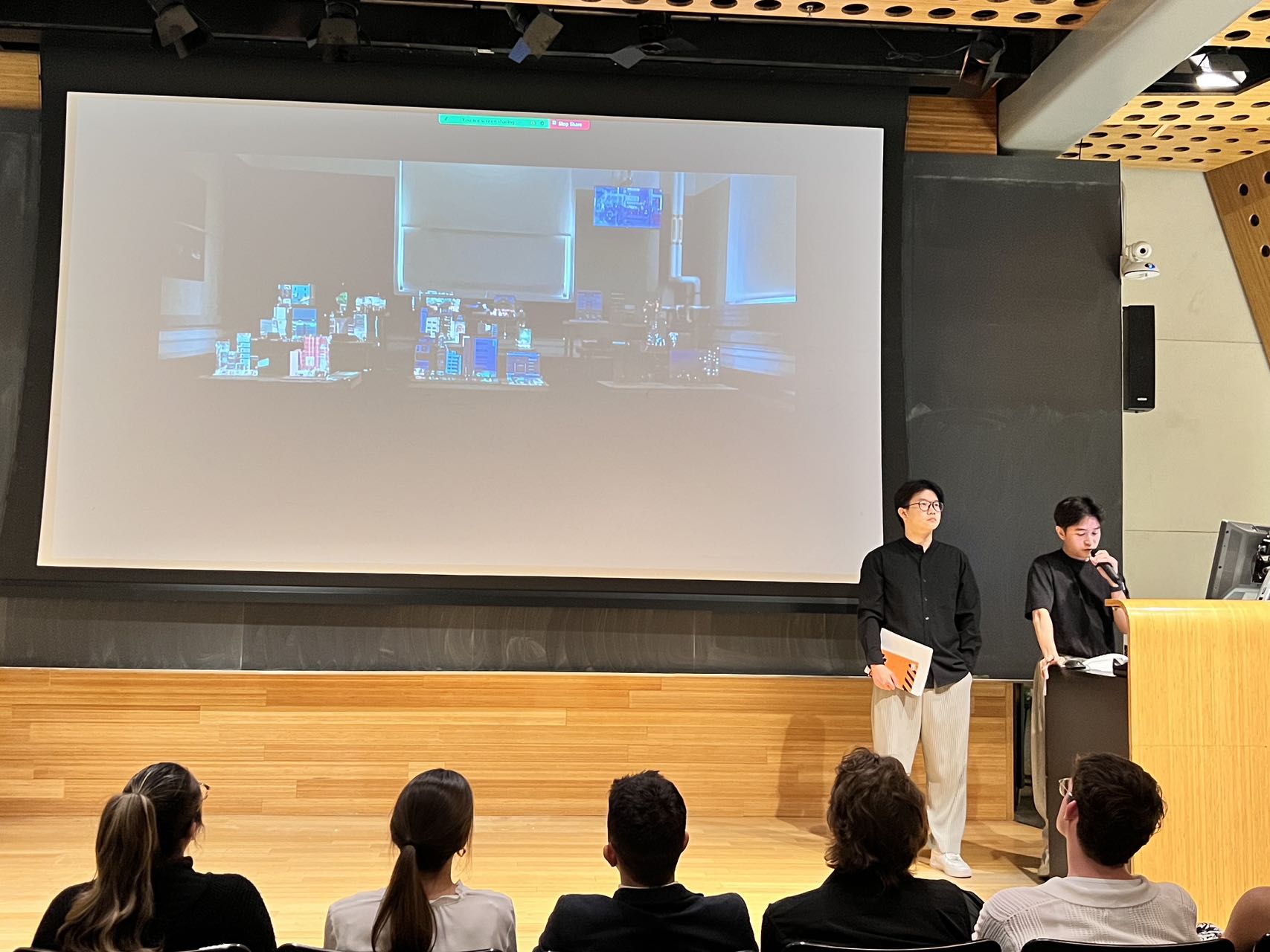

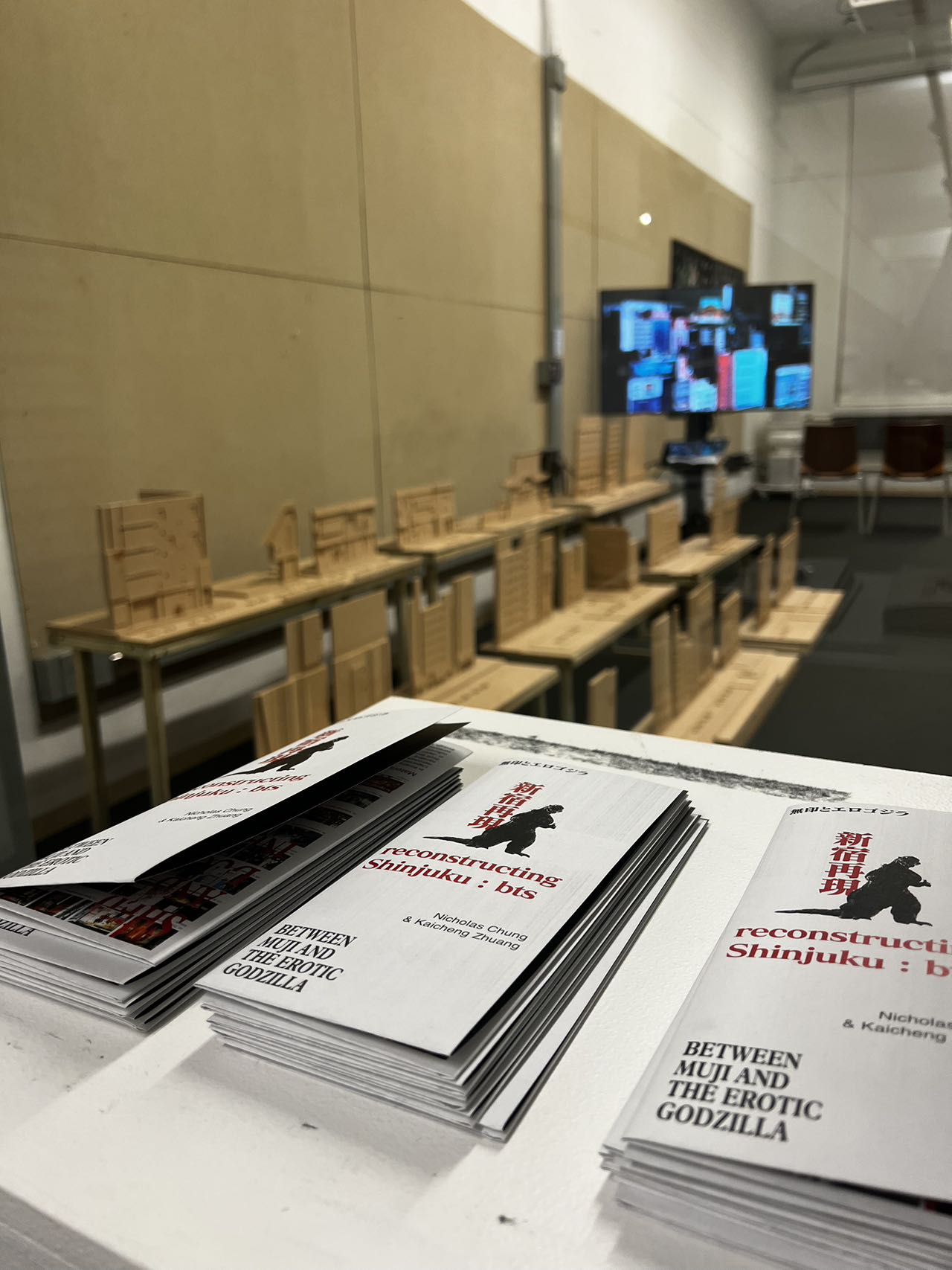

Britton Memorial Awards Presentations
Bibliography



Ashihara, Yoshinobu. The Aesthetic Townscape. The MIT Press, September 1984.
Fujimori, Terunobu. Under the Banner of Street Observation. The Street Observation Society, 1986.
Jinnai, Hidenobu. Tokyo, A Spatial Anthropology. University of California Press, August 1995.
Kon, Wajiro. “Retrospective”. Seigensha, January 2011.
Kuroda, Kengo and Kazuo Kajima. Made in Tokyo. Kajima Institute Publishing, 2001.
Morikawa, Kaichiro. Learning from Akihabara: The Birth of a Personapolis. VESTAL, 2007.
Kitayama, Koh. "Who Are the Agents of the City?" Harvard Design Magazine, vol. 29, 2008, pp. 56-63.
Kitayama, Koh, Yoshiharu Tsukamoto, and Ryue Nishizawa. Tokyo Metabolizing: A Dialogue on Urbanism. TOTO Shuppan, 2010.
Alkemade, Floris. Tabula Scripta. nai010 publishers, 2019.
Almazan, Andres and Jaemin Choe. The Extended Home: Rethinking the Smart Home Environment. Morgan & Claypool, 2019.
Cybriwsky, Ron. Tokyo: The Shogun's City at the 21st Century. Routledge, 2018.
Dovey, Kim, Robyn Dowling, Steve Pafka, and Doina Ristica, editors. Mapping Urbanities: Morphologies, Flows, Possibilities. Routledge, 2015.
Easterling, Keller. Extrastatecraft: The Power of Infrastructure Space. Verso, 2014.
Gehl, Jan. Life Between Buildings: Using Public Space. Translated by Jo Koch, Island Press, 2011.
Harvey, David. Rebel Cities: From the Right to the City to the Urban Revolution. Verso, 2012.
Koolhaas, Rem, and Hans Ulrich Obrist. Project Japan: Metabolism Talks... Taschen, 2011.
Lefebvre, Henri. The Right to the City. Translated by Eleonore Kofman and Elizabeth Lebas, Bloomsbury Academic, 1996.
Lefebvre, Henri. Writings on Cities. Edited and translated by Eleonore Kofman and Elizabeth Lebas. Blackwell Publishers, 1996.
Lucas, Ray. Anthropology for Architects: Social Relations and the Built Environment. Routledge, 2017.
Lydon, Mike and Anthony Garcia. Tactical Urbanism: Short-term Action for Long-term Change. Island Press, 2015.
McReynolds, Greg M. and Akinori Saito. Emergent Tokyo: Smart, Sustainable and Resilient Urbanism. Springer, 2020.
Oldenburg, Ray. The Great Good Place: Cafes, Coffee Shops, Bookstores, Bars, Hair Salons, and Other Hangouts at the Heart of a Community. Marlowe and Company, 1999.
Popham, Peter. Tokyo: City at the End of the World. Kodansha International, 1991.
Sarkis, Hashim, editor. Expansions: How Will We Live Together? Venice Biennale, Marsilio Editori, 2021.
Sassen, Saskia. The Global City: New York, London, Tokyo. Princeton University Press, 2001.
Soja, Edward W. Thirdspace: Journeys to Los Angeles and Other Real-and-Imagined Places. Blackwell Publishers, 1996.
Stavrides, Stavros. Common Space: The City as Commons. Zed Books, 2016.
Stavrides, Stavros. Towards a City of Thresholds: Overlapping Spaces of Public and Private. Routledge, 2010.
Venturi, Robert. Complexity and Contradiction in Architecture. Museum of Modern Art, 1966.
Venturi, Robert, and Denise Scott Brown. Learning from Las Vegas: The Forgotten Symbolism of Architectural Form. MIT Press, 1972.
Venturi, Robert, and Denise Scott Brown. "Two Naifs in Japan." Casabella, vol. 595, 1992, pp. 12-17.
Waley, Paul, editor. Fragments of a City: Tokyo Anthology. Reaktion Books, 1994.
A special thanks to:
Review Critics
Professor Abingo Wu, PhD
Professor Britt Eversole
Installation Assistants
Shen, Yifan
Zhang, Yihan

